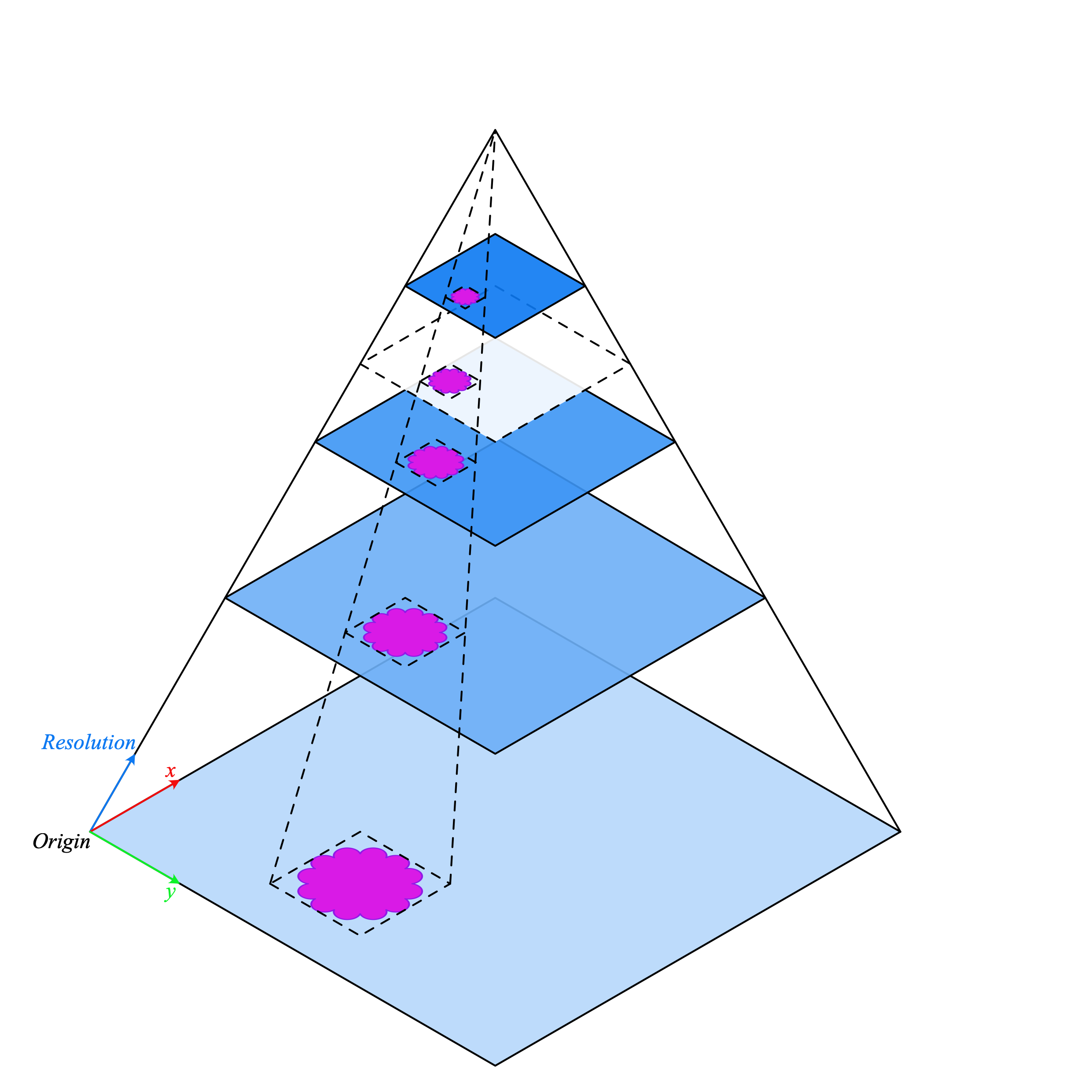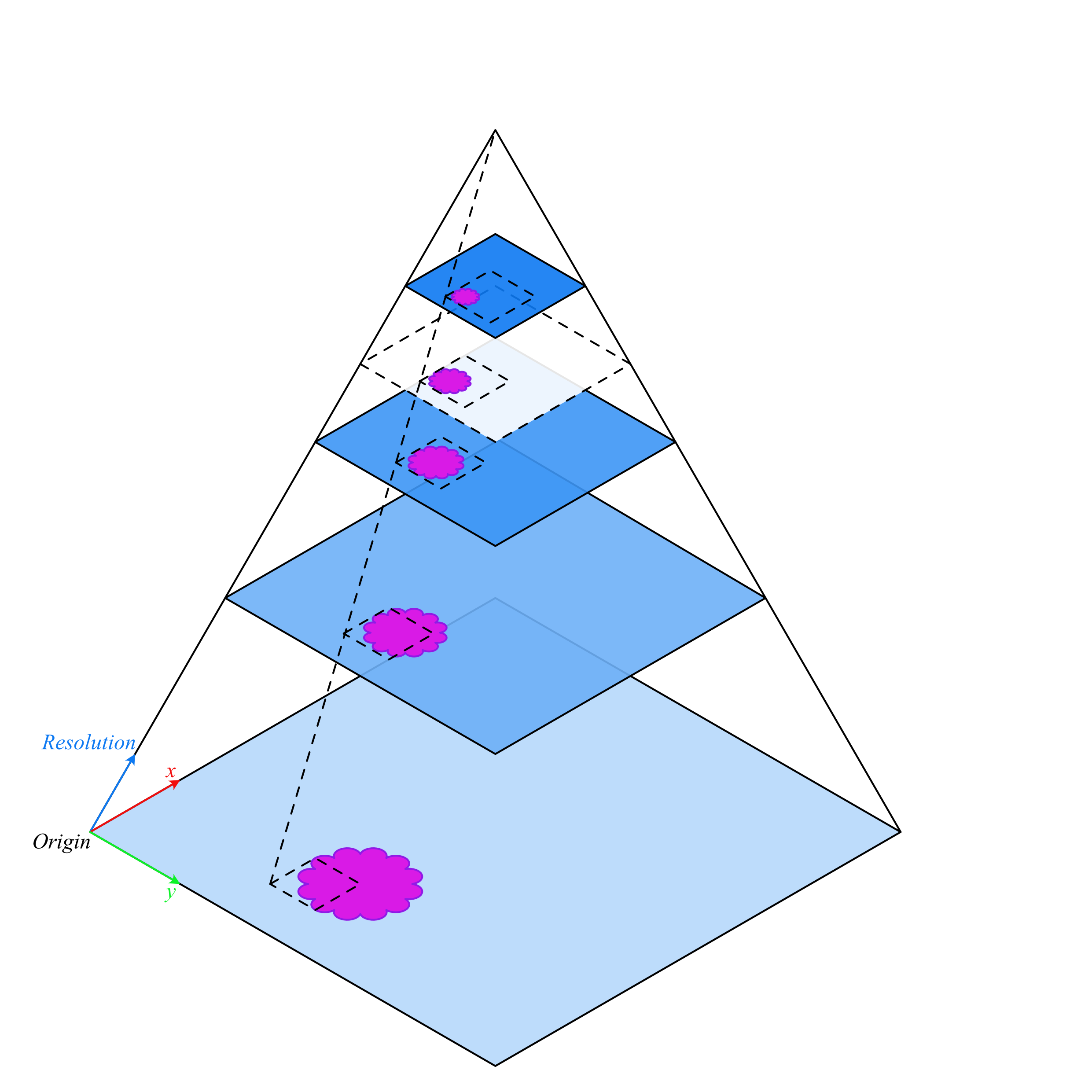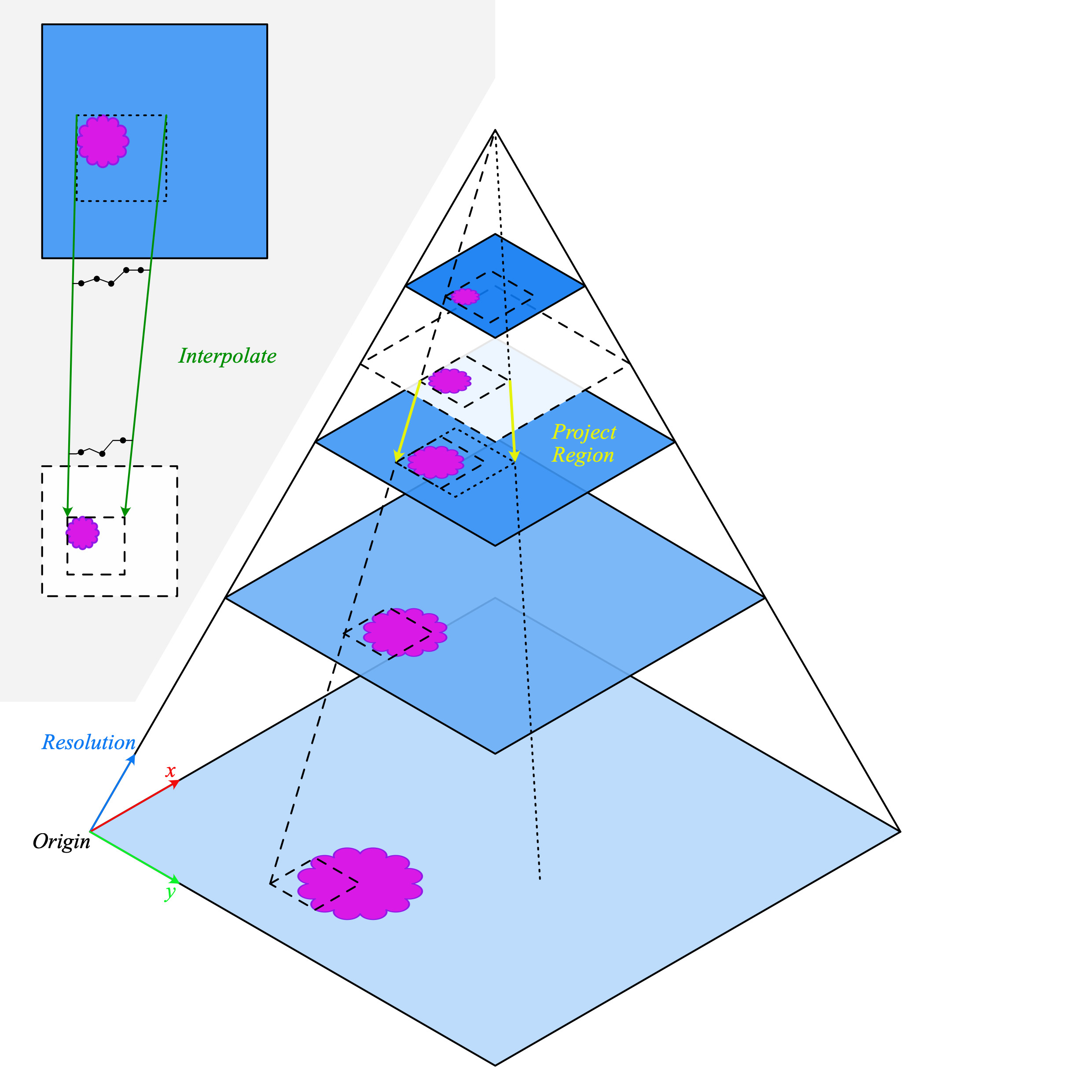JP2WSIReader¶
- class JP2WSIReader(input_img, mpp=None, power=None)[source]¶
Class for reading Omnyx JP2 images.
Supported WSI formats:
Omnyx JPEG-2000 (.jp2)
- Parameters:
- glymur_wsi¶
- Type:
glymur.Jp2k
Initialize
OmnyxJP2WSIReader.Methods
Read a region of the whole slide image within given bounds.
Read a region of the whole slide image at a location and size.
Attributes
- read_bounds(bounds, resolution=0, units='level', interpolation='optimise', pad_mode='constant', pad_constant_values=0, coord_space='baseline', **kwargs)[source]¶
Read a region of the whole slide image within given bounds.
Bounds are in terms of the baseline image (level 0 / maximum resolution).
Reads can be performed at different resolutions by supplying a pair of arguments for the resolution and the units of resolution. If metadata does not specify mpp or objective_power then baseline units should be selected with resolution 1.0
The output image size may be different to the width and height of the bounds as the resolution will affect this. To read a region with a fixed output image size see
read_rect().- Parameters:
bounds (IntBounds) – By default, this is a tuple of (start_x, start_y, end_x, end_y) i.e. (left, top, right, bottom) of the region in baseline reference frame. However, with coord_space=”resolution”, the bound is expected to be at the requested resolution system.
resolution (Resolution) – Resolution at which to read the image, default = 0. Either a single number or a sequence of two numbers for x and y are valid. This value is in terms of the corresponding units. For example: resolution=0.5 and units=”mpp” will read the slide at 0.5 microns per-pixel, and resolution=3, units=”level” will read at level at pyramid level / resolution layer 3.
units (Units) – Units of resolution, default=”level”. Supported units are: microns per pixel (mpp), objective power (power), pyramid / resolution level (level), pixels per baseline pixel (baseline).
interpolation (str) – Method to use when resampling the output image. Possible values are “linear”, “cubic”, “lanczos”, “area”, and “optimise”. Defaults to ‘optimise’ which will use cubic interpolation for upscaling and area interpolation for downscaling to avoid moiré patterns.
pad_mode (str) – Method to use when padding at the edges of the image. Defaults to ‘constant’. See
numpy.pad()for available modes.pad_constant_values (int, tuple(int)) – Constant values to use when padding with constant pad mode. Passed to the
numpy.pad()constant_values argument. Default is 0.coord_space (str) – Defaults to “baseline”. This is a flag to indicate if the input bounds is in the baseline coordinate system (“baseline”) or is in the requested resolution system (“resolution”).
**kwargs (dict) – Extra key-word arguments for reader specific parameters. Currently only used by
VirtualWSIReader. See class docstrings for more information.self (JP2WSIReader)
- Returns:
Array of size MxNx3 M=end_h-start_h, N=end_w-start_w
- Return type:
Examples
>>> from tiatoolbox.wsicore.wsireader import WSIReader >>> from matplotlib import pyplot as plt >>> wsi = WSIReader.open(input_img="./CMU-1.ndpi") >>> # Read a region at level 0 (baseline / full resolution) >>> bounds = [1000, 2000, 2000, 3000] >>> img = wsi.read_bounds(bounds) >>> plt.imshow(img) >>> # This could also be written more verbosely as follows >>> img = wsi.read_bounds( ... bounds, ... resolution=0, ... units="level", ... ) >>> plt.imshow(img)
Note: The field of view remains the same as resolution is varied when using
read_bounds().
This is because the bounds are in the baseline (level 0) reference frame. Therefore, varying the resolution does not change what is visible within the output image.
If the WSI does not have a resolution layer corresponding exactly to the requested resolution (shown above in white with a dashed outline), a larger resolution is downscaled to achieve the correct requested output resolution.
If the requested resolution is higher than the baseline (maximum resultion of the image), then bicubic interpolation is applied to the output image.
- read_rect(location, size, resolution=0, units='level', interpolation='optimise', pad_mode='constant', pad_constant_values=0, coord_space='baseline', **kwargs)[source]¶
Read a region of the whole slide image at a location and size.
Location is in terms of the baseline image (level 0 / maximum resolution), and size is the output image size.
Reads can be performed at different resolutions by supplying a pair of arguments for the resolution and the units of resolution. If metadata does not specify mpp or objective_power then baseline units should be selected with resolution 1.0
The field of view varies with resolution. For a fixed field of view see
read_bounds().- Parameters:
location (IntPair) – (x, y) tuple giving the top left pixel in the baseline (level 0) reference frame.
size (IntPair) – (width, height) tuple giving the desired output image size.
resolution (Resolution) – Resolution at which to read the image, default = 0. Either a single number or a sequence of two numbers for x and y are valid. This value is in terms of the corresponding units. For example: resolution=0.5 and units=”mpp” will read the slide at 0.5 microns per-pixel, and resolution=3, units=”level” will read at level at pyramid level / resolution layer 3.
units (Units) – The units of resolution, default = “level”. Supported units are: microns per pixel (mpp), objective power (power), pyramid / resolution level (level), pixels per baseline pixel (baseline).
interpolation (str) – Method to use when resampling the output image. Possible values are “linear”, “cubic”, “lanczos”, “area”, and “optimise”. Defaults to ‘optimise’ which will use cubic interpolation for upscaling and area interpolation for downscaling to avoid moiré patterns.
pad_mode (str) – Method to use when padding at the edges of the image. Defaults to ‘constant’. See
numpy.pad()for available modes.pad_constant_values (int, tuple(int)) – Constant values to use when padding with constant pad mode. Passed to the
numpy.pad()constant_values argument. Default is 0.coord_space (str) – Defaults to “baseline”. This is a flag to indicate if the input bounds is in the baseline coordinate system (“baseline”) or is in the requested resolution system (“resolution”).
**kwargs (dict) – Extra key-word arguments for reader specific parameters. Currently only used by VirtualWSIReader. See class docstrings for more information.
self (JP2WSIReader)
- Returns:
Array of size MxNx3 M=size[0], N=size[1]
- Return type:
Example
>>> from tiatoolbox.wsicore.wsireader import WSIReader >>> # Load a WSI image >>> wsi = WSIReader.open(input_img="./CMU-1.ndpi") >>> location = (0, 0) >>> size = (256, 256) >>> # Read a region at level 0 (baseline / full resolution) >>> img = wsi.read_rect(location, size) >>> # Read a region at 0.5 microns per pixel (mpp) >>> img = wsi.read_rect(location, size, 0.5, "mpp") >>> # This could also be written more verbosely as follows >>> img = wsi.read_rect( ... location, ... size, ... resolution=(0.5, 0.5), ... units="mpp", ... )
Note: The field of view varies with resolution when using
read_rect().
As the location is in the baseline reference frame but the size (width and height) is the output image size, the field of view therefore changes as resolution changes.
If the WSI does not have a resolution layer corresponding exactly to the requested resolution (shown above in white with a dashed outline), a larger resolution is downscaled to achieve the correct requested output resolution.
If the requested resolution is higher than the baseline (maximum resultion of the image), then bicubic interpolation is applied to the output image.

When reading between the levels stored in the WSI, the coordinates of the requested region are projected to the next highest resolution. This resolution is then decoded and downsampled to produce the desired output. This is a major source of variability in the time take to perform a read operation. Reads which require reading a large region before downsampling will be significantly slower than reading at a fixed level.
Examples
>>> from tiatoolbox.wsicore.wsireader import WSIReader >>> # Load a WSI image >>> wsi = WSIReader.open(input_img="./CMU-1.ndpi") >>> location = (0, 0) >>> size = (256, 256) >>> # The resolution can be different in x and y, e.g. >>> img = wsi.read_rect( ... location, ... size, ... resolution=(0.5, 0.75), ... units="mpp", ... ) >>> # Several units can be used including: objective power, >>> # microns per pixel, pyramid/resolution level, and >>> # fraction of baseline. >>> # E.g. Read a region at an objective power of 10x >>> img = wsi.read_rect( ... location, ... size, ... resolution=10, ... units="power", ... ) >>> # Read a region at pyramid / resolution level 1 >>> img = wsi.read_rect( ... location, ... size, ... resolution=1, ... units="level", ... ) >>> # Read at a fractional level, this will linearly >>> # interpolate the downsampling factor between levels. >>> # E.g. if levels 0 and 1 have a downsampling of 1x and >>> # 2x of baseline, then level 0.5 will correspond to a >>> # downsampling factor 1.5x of baseline. >>> img = wsi.read_rect( ... location, ... size, ... resolution=0.5, ... units="level", ... ) >>> # Read a region at half of the full / baseline >>> # resolution. >>> img = wsi.read_rect( ... location, ... size, ... resolution=0.5, ... units="baseline", ... ) >>> # Read at a higher resolution than the baseline >>> # (interpolation applied to output) >>> img = wsi.read_rect( ... location, ... size, ... resolution=1.25, ... units="baseline", ... ) >>> # Assuming the image has a native mpp of 0.5, >>> # interpolation will be applied here. >>> img = wsi.read_rect( ... location, ... size, ... resolution=0.25, ... units="mpp", ... )